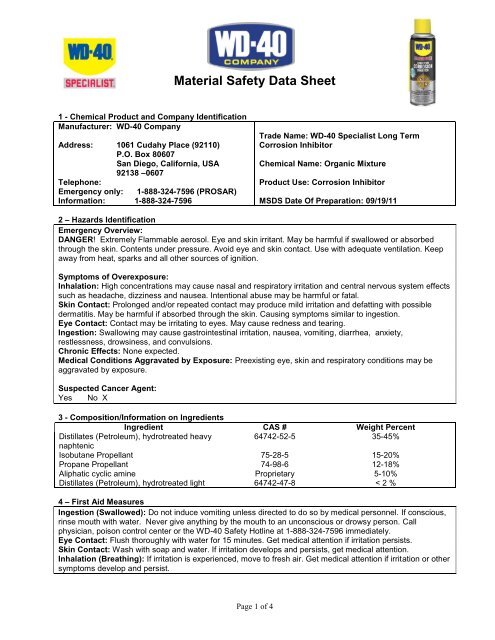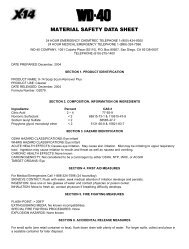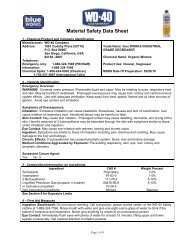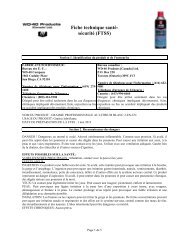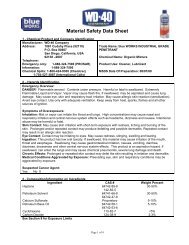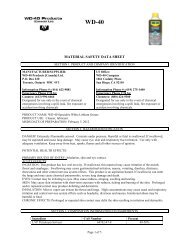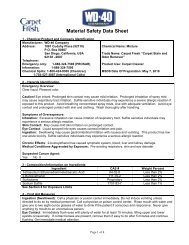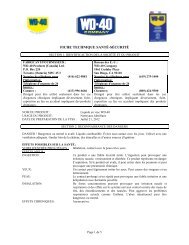Material Safety Data Sheet (MSDS) - WD-40 Company
Material Safety Data Sheet (MSDS) - WD-40 Company
Material Safety Data Sheet (MSDS) - WD-40 Company
You also want an ePaper? Increase the reach of your titles
YUMPU automatically turns print PDFs into web optimized ePapers that Google loves.
<strong>Material</strong> <strong>Safety</strong> <strong>Data</strong> <strong>Sheet</strong><br />
1 - Chemical Product and <strong>Company</strong> Identification<br />
Manufacturer: <strong>WD</strong>-<strong>40</strong> <strong>Company</strong><br />
Address: 1061 Cudahy Place (92110)<br />
P.O. Box 80607<br />
San Diego, California, USA<br />
92138 –0607<br />
Telephone:<br />
Emergency only: 1-888-324-7596 (PROSAR)<br />
Information: 1-888-324-7596<br />
Trade Name: <strong>WD</strong>-<strong>40</strong> Specialist Long Term<br />
Corrosion Inhibitor<br />
Chemical Name: Organic Mixture<br />
Product Use: Corrosion Inhibitor<br />
<strong>MSDS</strong> Date Of Preparation: 09/19/11<br />
2 – Hazards Identification<br />
Emergency Overview:<br />
DANGER! Extremely Flammable aerosol. Eye and skin irritant. May be harmful if swallowed or absorbed<br />
through the skin. Contents under pressure. Avoid eye and skin contact. Use with adequate ventilation. Keep<br />
away from heat, sparks and all other sources of ignition.<br />
Symptoms of Overexposure:<br />
Inhalation: High concentrations may cause nasal and respiratory irritation and central nervous system effects<br />
such as headache, dizziness and nausea. Intentional abuse may be harmful or fatal.<br />
Skin Contact: Prolonged and/or repeated contact may produce mild irritation and defatting with possible<br />
dermatitis. May be harmful if absorbed through the skin. Causing symptoms similar to ingestion.<br />
Eye Contact: Contact may be irritating to eyes. May cause redness and tearing.<br />
Ingestion: Swallowing may cause gastrointestinal irritation, nausea, vomiting, diarrhea, anxiety,<br />
restlessness, drowsiness, and convulsions.<br />
Chronic Effects: None expected.<br />
Medical Conditions Aggravated by Exposure: Preexisting eye, skin and respiratory conditions may be<br />
aggravated by exposure.<br />
Suspected Cancer Agent:<br />
Yes No X<br />
3 - Composition/Information on Ingredients<br />
Ingredient CAS # Weight Percent<br />
Distillates (Petroleum), hydrotreated heavy<br />
64742-52-5 35-45%<br />
naphtenic<br />
Isobutane Propellant 75-28-5 15-20%<br />
Propane Propellant 74-98-6 12-18%<br />
Aliphatic cyclic amine Proprietary 5-10%<br />
Distillates (Petroleum), hydrotreated light 64742-47-8 < 2 %<br />
4 – First Aid Measures<br />
Ingestion (Swallowed): Do not induce vomiting unless directed to do so by medical personnel. If conscious,<br />
rinse mouth with water. Never give anything by the mouth to an unconscious or drowsy person. Call<br />
physician, poison control center or the <strong>WD</strong>-<strong>40</strong> <strong>Safety</strong> Hotline at 1-888-324-7596 immediately.<br />
Eye Contact: Flush thoroughly with water for 15 minutes. Get medical attention if irritation persists.<br />
Skin Contact: Wash with soap and water. If irritation develops and persists, get medical attention.<br />
Inhalation (Breathing): If irritation is experienced, move to fresh air. Get medical attention if irritation or other<br />
symptoms develop and persist.<br />
Page 1 of 4
5 – Fire Fighting Measures<br />
Extinguishing Media: Use water fog, dry chemical, carbon dioxide or foam. Do not use water jet or flooding<br />
amounts of water. Burning product will float on the surface and spread fire.<br />
Special Fire Fighting Procedures: Firefighters should always wear positive pressure self-contained<br />
breathing apparatus and full protective clothing. Cool fire-exposed containers with water. Use shielding to<br />
protect against bursting containers.<br />
Unusual Fire and Explosion Hazards: Extremely flammable. Contents under pressure. Aerosol containers<br />
may burst under fire conditions. Vapors are heavier than air and may travel along surfaces to remote ignition<br />
sources and flash back.<br />
6 – Accidental Release Measures<br />
Wear appropriate protective clothing (see Section 8). Eliminate all sources of ignition and ventilate area.<br />
Leaking cans should be placed in a plastic bag or open pail until the pressure has dissipated. Contain and<br />
collect liquid with an inert absorbent and place in a container for disposal. Clean spill area thoroughly. Report<br />
spills to authorities as required.<br />
7 – Handling and Storage<br />
Handling: Avoid contact with eyes. Avoid prolonged contact with skin. Avoid breathing vapors or aerosols.<br />
Use with adequate ventilation. Keep away from heat, sparks, pilot lights, hot surfaces and open flames.<br />
Unplug electrical tools, motors, and appliances before spraying, or bringing can near any source of electricity.<br />
To avoid serious burn injury, do not let the can touch battery terminals, electrical connections on motors, or<br />
appliances, or any other source of electricity. Wash thoroughly with soap and water after handling. Do not<br />
puncture or incinerate containers. Keep can away from electrical current or battery terminals. Electrical arcing<br />
can cause burn-through (puncture) which may result in flash fire, causing serious injury. Keep out of the reach<br />
of children.<br />
Storage: Do not store above 120F or in direct sunlight. U.F.C (NFPA 30B) Level 3 Aerosol.<br />
8 – Exposure Controls/Personal Protection<br />
Chemical<br />
Occupational Exposure Limits<br />
Distillates (Petroleum), 5 mg/m 3 TWA ACGIH TLV (Inhalable)<br />
hydrotreated heavy naphtenic 5 mg/m 3 TWA OSHA PEL<br />
Isobutane Propellant<br />
1000 ppm TWA ACGIH TLV (aliphatic hydrocarbon gas)<br />
Propane Propellant<br />
Distillates (Petroleum),<br />
hydrotreated light<br />
Aliphatic cyclic amine<br />
1000 ppm TWA OSHA PEL<br />
1000 ppm TWA ACGIH TLV (aliphatic hydrocarbon gas)<br />
5 mg/m 3 TWA ACGIH TLV (Inhalable)<br />
5 mg/m 3 TWA OSHA PEL<br />
None Established<br />
The Following Controls are Recommended for Normal Consumer Use of this Product<br />
Engineering Controls: Use in a well-ventilated area.<br />
Personal Protection:<br />
Eye Protection: Avoid eye contact. <strong>Safety</strong> glasses or goggles recommended.<br />
Skin Protection: Avoid skin contact. Chemical resistant gloves recommended for operations where skin<br />
contact is likely.<br />
Respiratory Protection: None needed for normal use with adequate ventilation.<br />
For Bulk Processing or Workplace Use the Following Controls are Recommended<br />
Engineering Controls: Use adequate general and local exhaust ventilation to maintain exposure levels<br />
below that occupational exposure limits.<br />
Personal Protection:<br />
Eye Protection: <strong>Safety</strong> goggles recommended where eye contact is possible.<br />
Skin Protection: Wear chemical resistant gloves.<br />
Page 2 of 4
Respiratory Protection: None required if ventilation is adequate. If the occupational exposure limits are<br />
exceeded, wear a NIOSH approved respirator. Respirator selection and use should be based on contaminant<br />
type, form and concentration. Follow OSHA 1910.134, ANSI Z88.2 and good Industrial Hygiene practice.<br />
Work/Hygiene Practices: Wash with soap and water after handling.<br />
9 – Physical and Chemical Properties<br />
Boiling Point: Not Determined Specific Gravity: 0.90-0.91 @ 68F (20C)<br />
Solubility in Water: Insoluble pH: Not Applicable<br />
Vapor Pressure: 6226mm Hg @ 68F (20C) Vapor Density: Greater than 1<br />
Percent Volatile: > 90% VOC: 50%<br />
Coefficient of<br />
Water/Oil Distribution:<br />
Not Determined Appearance/Odor Tan liquid with a petroleum<br />
odor<br />
Flash Point: Not Determined Flammable Limits: LEL: 1.7% UEL: 10.9%<br />
Viscosity 1000 cps @ 100F (38C) Ignition temperature 860F (460C)<br />
10 – Stability and Reactivity<br />
Stability: Stable<br />
Hazardous Polymerization: Will not occur.<br />
Conditions to Avoid: Avoid heat, sparks, flames and other sources of ignition. Do not puncture or incinerate<br />
containers.<br />
Incompatibilities: Strong oxidizing agents.<br />
Hazardous Decomposition Products: Carbon monoxide and carbon dioxide, smoke fumes, and unburned<br />
hydrocarbons.<br />
11 – Toxicological Information<br />
No toxicity data is available.<br />
None of the components of this product is listed as a carcinogen or suspected carcinogen or is considered a<br />
reproductive hazard.<br />
12 – Ecological Information<br />
No data is currently available.<br />
13 - Disposal Considerations<br />
If this product becomes a waste, it would be expected to meet the criteria of a RCRA ignitable hazardous<br />
waste (D001). However, it is the responsibility of the generator to determine at the time of disposal the proper<br />
classification and method of disposal. Dispose in accordance with federal, state, and local regulations.<br />
14 – Transportation Information_<br />
DOT Surface Shipping Description: (The following applies until 12/31/2013 for transport by ground)<br />
Consumer Commodity, ORM-D<br />
(Effective 1/1/2014 - UN1950, Aerosols, 2.1 Limited Quantity)<br />
IMDG Shipping Description: UN1950, Aerosols, 2.1<br />
15 – Regulatory Information<br />
U.S. Federal Regulations:<br />
CERCLA 103 Reportable Quantity: This product is not subject to CERCLA reporting requirements,<br />
however, oil spills are reportable to the National Response Center under the Clean Water Act and many<br />
states have more stringent release reporting requirements. Report spills required under federal, state and<br />
local regulations.<br />
SARA TITLE III:<br />
Hazard Category For Section 311/312: Acute Health, Fire Hazard, Sudden Release of Pressure<br />
Page 3 of 4
Section 313 Toxic Chemicals: This product contains the following chemicals subject to SARA Title III<br />
Section 313 Reporting requirements: None<br />
Section 302 Extremely Hazardous Substances (TPQ): None<br />
EPA Toxic Substances Control Act (TSCA) Status: All of the components of this product are listed on the<br />
TSCA inventory<br />
California Safe Drinking Water and Toxic Enforcement Act (Proposition 65): This product does not<br />
contain chemicals regulated under California Proposition 65.<br />
VOC Regulations: This product complies with the consumer product VOC limits of CARB, the US EPA and<br />
states adopting the OTC VOC rules.<br />
Canadian Environmental Protection Act: All of the ingredients are listed on the Canadian Domestic<br />
Substances List or exempt from notification<br />
Canadian WHMIS Classification: Class B-5 (Flammable Aerosol), Class D-2-B (Eye and skin irritant.)<br />
This <strong>MSDS</strong> has been prepared according to the criteria of the Controlled Products Regulation (CPR) and the<br />
<strong>MSDS</strong> contains all of the information required by the CPR.<br />
16 – Other Information:<br />
HMIS Hazard Rating:<br />
Health – 2 (moderate hazard), Fire Hazard – 4 (severe hazard), Physical Hazard – 0 (minimal hazard)<br />
SIGNATURE:<br />
TITLE:Director of Global Consumer Relations and Regulatory Affairs<br />
REVISION DATE: September 2011 SUPERSEDES: New<br />
Page 4 of 4


